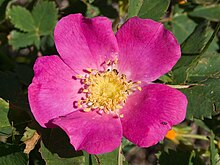Rosa woodsii
| Rosa woodsii | |
|---|---|
 | |
| Closeup of flower | |
Conservation status | |
 Secure (NatureServe) | |
| Scientific classification | |
| Kingdom: | Plantae |
| Clade: | Tracheophytes |
| Clade: | Angiosperms |
| Clade: | Eudicots |
| Clade: | Rosids |
| Order: | Rosales |
| Family: | Rosaceae |
| Genus: | Rosa |
| Species: | R. woodsii |
| Binomial name | |
| Rosa woodsii Lindl. | |
Rosa woodsii is a species of wild rose known by the common names Woods' rose,[1] interior rose,[2] common wild rose, mountain rose, pear-hip rose, and prairie rose.[3]
Description
Rosa woodsii is a perennial[4] bushy shrub which grows up to 3 metres (10 feet) tall. The shrubs can form large, dense thickets. The plant reproduces sexually by seed and vegetatively by sprouting from the root crown, layering, and by producing root suckers.[1]
The stems are straight, red to grey-brown and studded with prickles.[3] The deciduous leaves are each made up of several widely spaced sharp-toothed leaflets up to 5 centimetres (2 inches) long.
The inflorescence is a cyme of up to a few fragrant flowers with five petals in any shade of pink and measuring up to 2.5 cm in length. Flowers bloom between May and July and have many stamens and pistils.[3] The fruit is a red rose hip which may be over 1 cm long and matures in August to September.[3] They can be eaten, used in tea or as medicine.[5]
- Prickle (closeup)
-
 Rose hips of Rosa woodsii
Rose hips of Rosa woodsii -
 Lighter pink flower, at 7,000 ft (2,100 m) in the Eastern Sierra
Lighter pink flower, at 7,000 ft (2,100 m) in the Eastern Sierra - Rosa woodsii on Raspberry Island (Alaska)
Distribution and habitat
It is native to North America including much of Canada and Alaska and the western and central United States. It grows in a variety of habitats such as open woods, plains, stream banks, stony slopes[4] and disturbed areas.[1]
In the Sierra Nevada, it grows to 3,400 m (11,200 ft) in moist, rocky soils in mixed coniferous forest, upper montane forest, and subalpine forest.[2]
In culture
The flower was featured as one of four different wildflowers on U.S. postage stamps issued in 2022.
References
- ^ a b c Hauser, A. Scott (2006). "Rosa woodsii". Fire Effects Information System (FEIS). US Department of Agriculture (USDA), Forest Service (USFS), Rocky Mountain Research Station, Fire Sciences Laboratory. Retrieved 2014-01-21.
- ^ a b Wiese, Karen (2013). Sierra Nevada Wildflowers (2nd ed.). p. 89.
- ^ a b c d Pavek, P.L.S; Skinner, D.M. (2013). Plant guide for Woods’ rose (Rosa woodsii Lindl.) (PDF). Pullman, WA: USDA Natural Resources Conservation Service.
- ^ a b "Lady Bird Johnson Wildflower Center - The University of Texas at Austin". www.wildflower.org. Retrieved 2021-11-11.
- ^ Fagan, Damian (2019). Wildflowers of Oregon: A Field Guide to Over 400 Wildflowers, Trees, and Shrubs of the Coast, Cascades, and High Desert. Guilford, CT: FalconGuides. p. 222. ISBN 978-1-4930-3633-2. OCLC 1073035766.
External links
- Jepson Manual treatment - Rosa woodsii
- Washington Burke Museum
- Southwest Colorado Wildflowers
- Rosa woodsii in the CalPhotos photo database, University of California, Berkeley
 Media related to Rosa woodsii at Wikimedia Commons
Media related to Rosa woodsii at Wikimedia Commons
- v
- t
- e















